Projects Negotiation and Conflict Report for Queensland Health Payroll Program
VerifiedAdded on 2023/06/13
|6
|1695
|177
AI Summary
This report discusses the negotiation and conflict management strategies for four projects under the Queensland Health Payroll Program. It includes project characteristics, participants, negotiation interaction process, negotiation methods, and preferred form of procurement for each project.
Contribute Materials
Your contribution can guide someone’s learning journey. Share your
documents today.
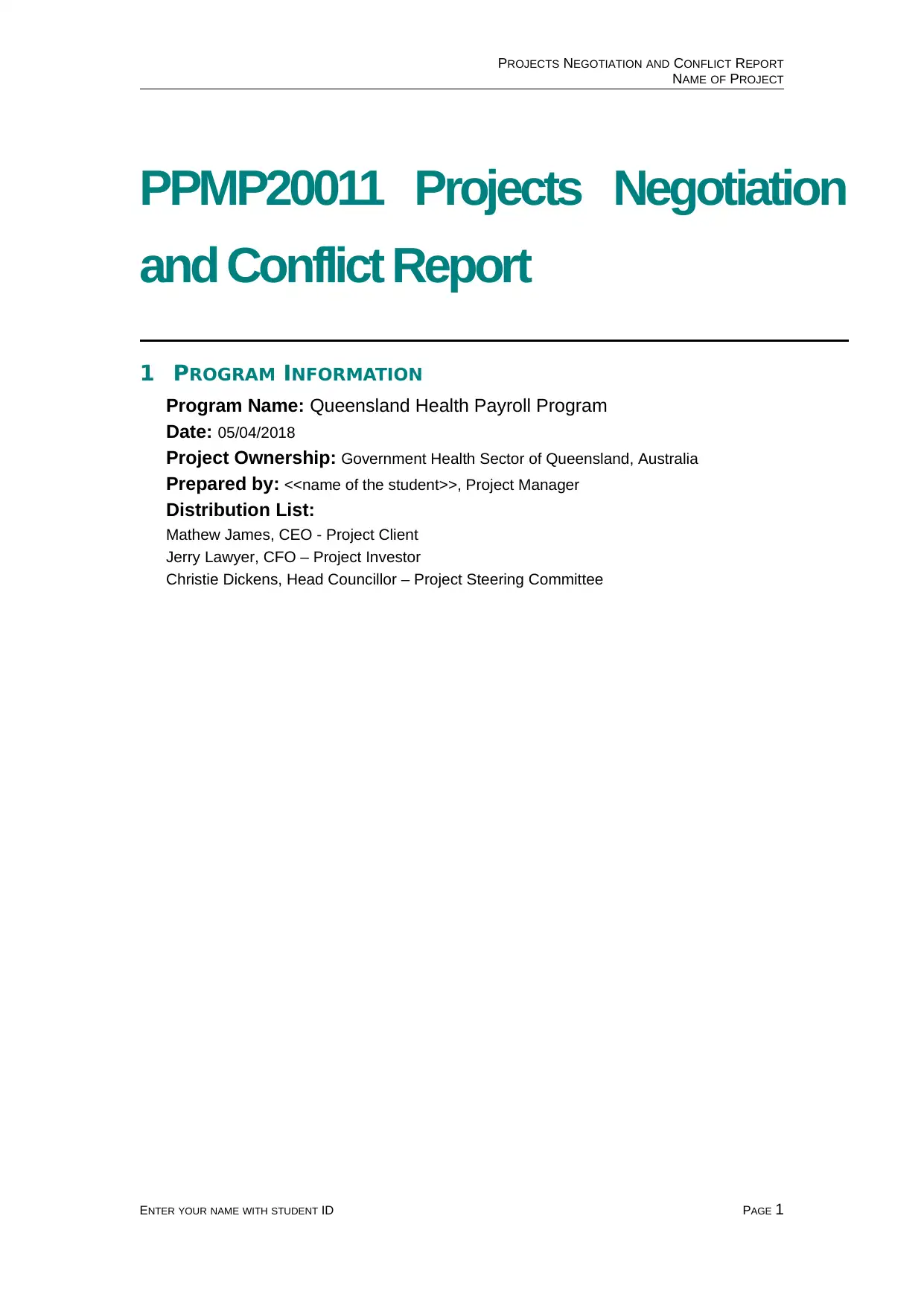
PROJECTS NEGOTIATION AND CONFLICT REPORT
NAME OF PROJECT
PPMP20011 Projects Negotiation
and Conflict Report
1 PROGRAM INFORMATION
Program Name: Queensland Health Payroll Program
Date: 05/04/2018
Project Ownership: Government Health Sector of Queensland, Australia
Prepared by: <<name of the student>>, Project Manager
Distribution List:
Mathew James, CEO - Project Client
Jerry Lawyer, CFO – Project Investor
Christie Dickens, Head Councillor – Project Steering Committee
ENTER YOUR NAME WITH STUDENT ID PAGE 1
NAME OF PROJECT
PPMP20011 Projects Negotiation
and Conflict Report
1 PROGRAM INFORMATION
Program Name: Queensland Health Payroll Program
Date: 05/04/2018
Project Ownership: Government Health Sector of Queensland, Australia
Prepared by: <<name of the student>>, Project Manager
Distribution List:
Mathew James, CEO - Project Client
Jerry Lawyer, CFO – Project Investor
Christie Dickens, Head Councillor – Project Steering Committee
ENTER YOUR NAME WITH STUDENT ID PAGE 1
Secure Best Marks with AI Grader
Need help grading? Try our AI Grader for instant feedback on your assignments.
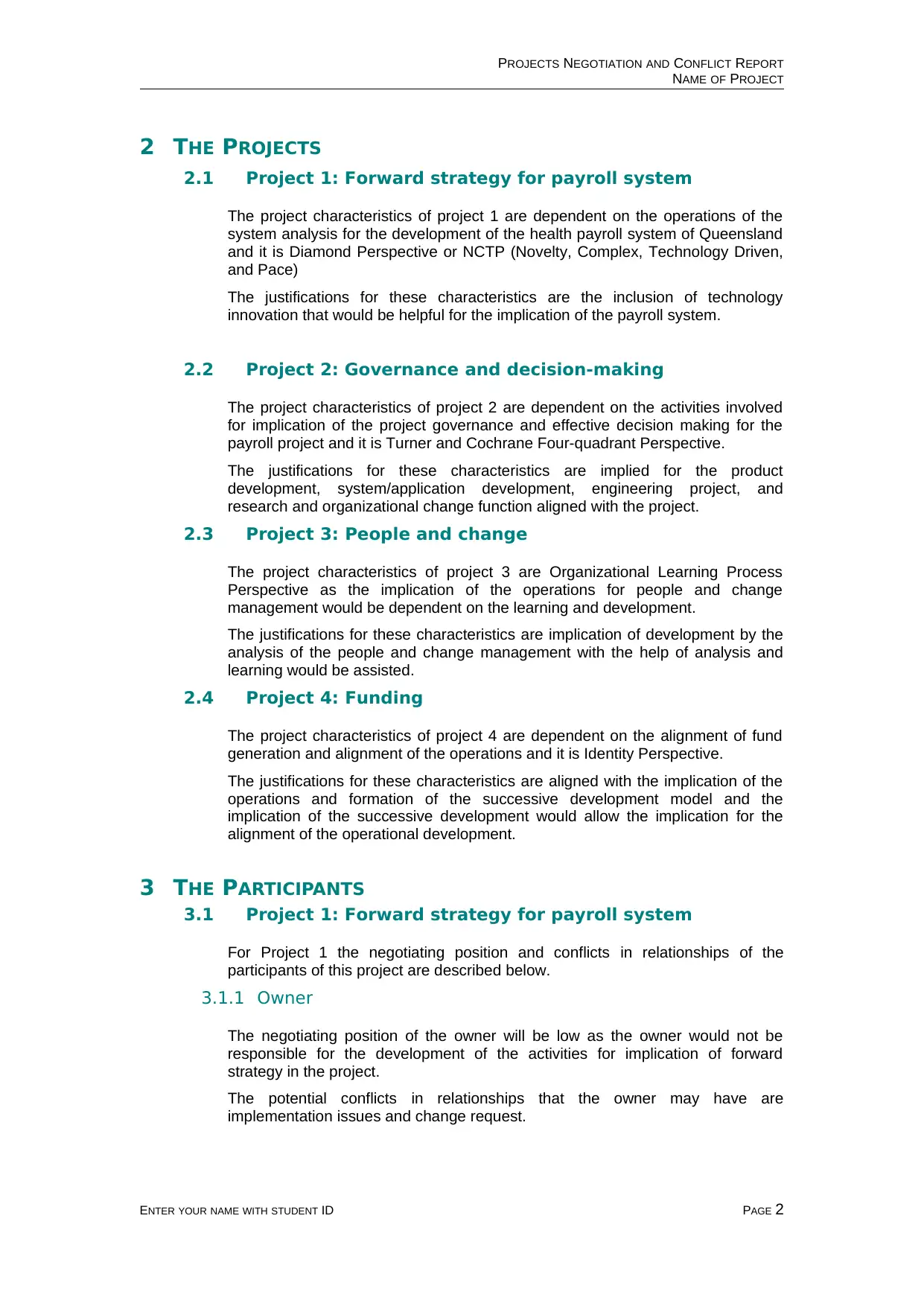
PROJECTS NEGOTIATION AND CONFLICT REPORT
NAME OF PROJECT
2 THE PROJECTS
2.1 Project 1: Forward strategy for payroll system
The project characteristics of project 1 are dependent on the operations of the
system analysis for the development of the health payroll system of Queensland
and it is Diamond Perspective or NCTP (Novelty, Complex, Technology Driven,
and Pace)
The justifications for these characteristics are the inclusion of technology
innovation that would be helpful for the implication of the payroll system.
2.2 Project 2: Governance and decision-making
The project characteristics of project 2 are dependent on the activities involved
for implication of the project governance and effective decision making for the
payroll project and it is Turner and Cochrane Four-quadrant Perspective.
The justifications for these characteristics are implied for the product
development, system/application development, engineering project, and
research and organizational change function aligned with the project.
2.3 Project 3: People and change
The project characteristics of project 3 are Organizational Learning Process
Perspective as the implication of the operations for people and change
management would be dependent on the learning and development.
The justifications for these characteristics are implication of development by the
analysis of the people and change management with the help of analysis and
learning would be assisted.
2.4 Project 4: Funding
The project characteristics of project 4 are dependent on the alignment of fund
generation and alignment of the operations and it is Identity Perspective.
The justifications for these characteristics are aligned with the implication of the
operations and formation of the successive development model and the
implication of the successive development would allow the implication for the
alignment of the operational development.
3 THE PARTICIPANTS
3.1 Project 1: Forward strategy for payroll system
For Project 1 the negotiating position and conflicts in relationships of the
participants of this project are described below.
3.1.1 Owner
The negotiating position of the owner will be low as the owner would not be
responsible for the development of the activities for implication of forward
strategy in the project.
The potential conflicts in relationships that the owner may have are
implementation issues and change request.
ENTER YOUR NAME WITH STUDENT ID PAGE 2
NAME OF PROJECT
2 THE PROJECTS
2.1 Project 1: Forward strategy for payroll system
The project characteristics of project 1 are dependent on the operations of the
system analysis for the development of the health payroll system of Queensland
and it is Diamond Perspective or NCTP (Novelty, Complex, Technology Driven,
and Pace)
The justifications for these characteristics are the inclusion of technology
innovation that would be helpful for the implication of the payroll system.
2.2 Project 2: Governance and decision-making
The project characteristics of project 2 are dependent on the activities involved
for implication of the project governance and effective decision making for the
payroll project and it is Turner and Cochrane Four-quadrant Perspective.
The justifications for these characteristics are implied for the product
development, system/application development, engineering project, and
research and organizational change function aligned with the project.
2.3 Project 3: People and change
The project characteristics of project 3 are Organizational Learning Process
Perspective as the implication of the operations for people and change
management would be dependent on the learning and development.
The justifications for these characteristics are implication of development by the
analysis of the people and change management with the help of analysis and
learning would be assisted.
2.4 Project 4: Funding
The project characteristics of project 4 are dependent on the alignment of fund
generation and alignment of the operations and it is Identity Perspective.
The justifications for these characteristics are aligned with the implication of the
operations and formation of the successive development model and the
implication of the successive development would allow the implication for the
alignment of the operational development.
3 THE PARTICIPANTS
3.1 Project 1: Forward strategy for payroll system
For Project 1 the negotiating position and conflicts in relationships of the
participants of this project are described below.
3.1.1 Owner
The negotiating position of the owner will be low as the owner would not be
responsible for the development of the activities for implication of forward
strategy in the project.
The potential conflicts in relationships that the owner may have are
implementation issues and change request.
ENTER YOUR NAME WITH STUDENT ID PAGE 2

PROJECTS NEGOTIATION AND CONFLICT REPORT
NAME OF PROJECT
3.1.2 Designers
The negotiating position of the designers will be high as the forward strategy of
payroll project would include the implication of the successive development.
The potential conflicts in relationships that the designers may have are design
failure and supplementary change implication.
3.1.3 Contractors
The negotiating position of the contractors will be high as the contractor would
play significant role for the project forward strategy development.
The potential conflicts in relationships that the contractors may have are delay
and quality issues.
3.2 Project 2: Governance and decision-making
For Project 2 the negotiating position and conflicts in relationships of the
participants of this project are described below.
3.2.1 Owner
The negotiating position of the owner will be high as the payroll project would
require the owner for forming the project governance and key decision making.
The potential conflicts in relationships that the owner may have are denial of
services and issue development.
3.2.2 Designers
The negotiating position of the designers will be low as they are not included for
the project governance and key decision making.
The potential conflicts in relationships that the designers may have are
combinational issues and alignment problems.
3.2.3 Contractors
The negotiating position of the contractors will be medium as the implication of
project key decision would involve the role of the contractors.
The potential conflicts in relationships that the contractors may have are violation
of negotiation and decision rejection.
3.3 Project 3: People and change
For Project 3 the negotiating position and conflicts in relationships of the
participants of this project are described below.
3.3.1 Owner
The negotiating position of the owner will be medium as the main management
of the people and change would be dependent on the project manager and the
project owner would assist in the processes.
The potential conflicts in relationships that the owner may have are lack of
information and compliance issues.
3.3.2 Designers
The negotiating position of the designers will be low as the change management
and people management would not be responsibility of the designer.
The potential conflicts in relationships that the designers may have are change
implication issues and violation of design requirements.
ENTER YOUR NAME WITH STUDENT ID PAGE 3
NAME OF PROJECT
3.1.2 Designers
The negotiating position of the designers will be high as the forward strategy of
payroll project would include the implication of the successive development.
The potential conflicts in relationships that the designers may have are design
failure and supplementary change implication.
3.1.3 Contractors
The negotiating position of the contractors will be high as the contractor would
play significant role for the project forward strategy development.
The potential conflicts in relationships that the contractors may have are delay
and quality issues.
3.2 Project 2: Governance and decision-making
For Project 2 the negotiating position and conflicts in relationships of the
participants of this project are described below.
3.2.1 Owner
The negotiating position of the owner will be high as the payroll project would
require the owner for forming the project governance and key decision making.
The potential conflicts in relationships that the owner may have are denial of
services and issue development.
3.2.2 Designers
The negotiating position of the designers will be low as they are not included for
the project governance and key decision making.
The potential conflicts in relationships that the designers may have are
combinational issues and alignment problems.
3.2.3 Contractors
The negotiating position of the contractors will be medium as the implication of
project key decision would involve the role of the contractors.
The potential conflicts in relationships that the contractors may have are violation
of negotiation and decision rejection.
3.3 Project 3: People and change
For Project 3 the negotiating position and conflicts in relationships of the
participants of this project are described below.
3.3.1 Owner
The negotiating position of the owner will be medium as the main management
of the people and change would be dependent on the project manager and the
project owner would assist in the processes.
The potential conflicts in relationships that the owner may have are lack of
information and compliance issues.
3.3.2 Designers
The negotiating position of the designers will be low as the change management
and people management would not be responsibility of the designer.
The potential conflicts in relationships that the designers may have are change
implication issues and violation of design requirements.
ENTER YOUR NAME WITH STUDENT ID PAGE 3
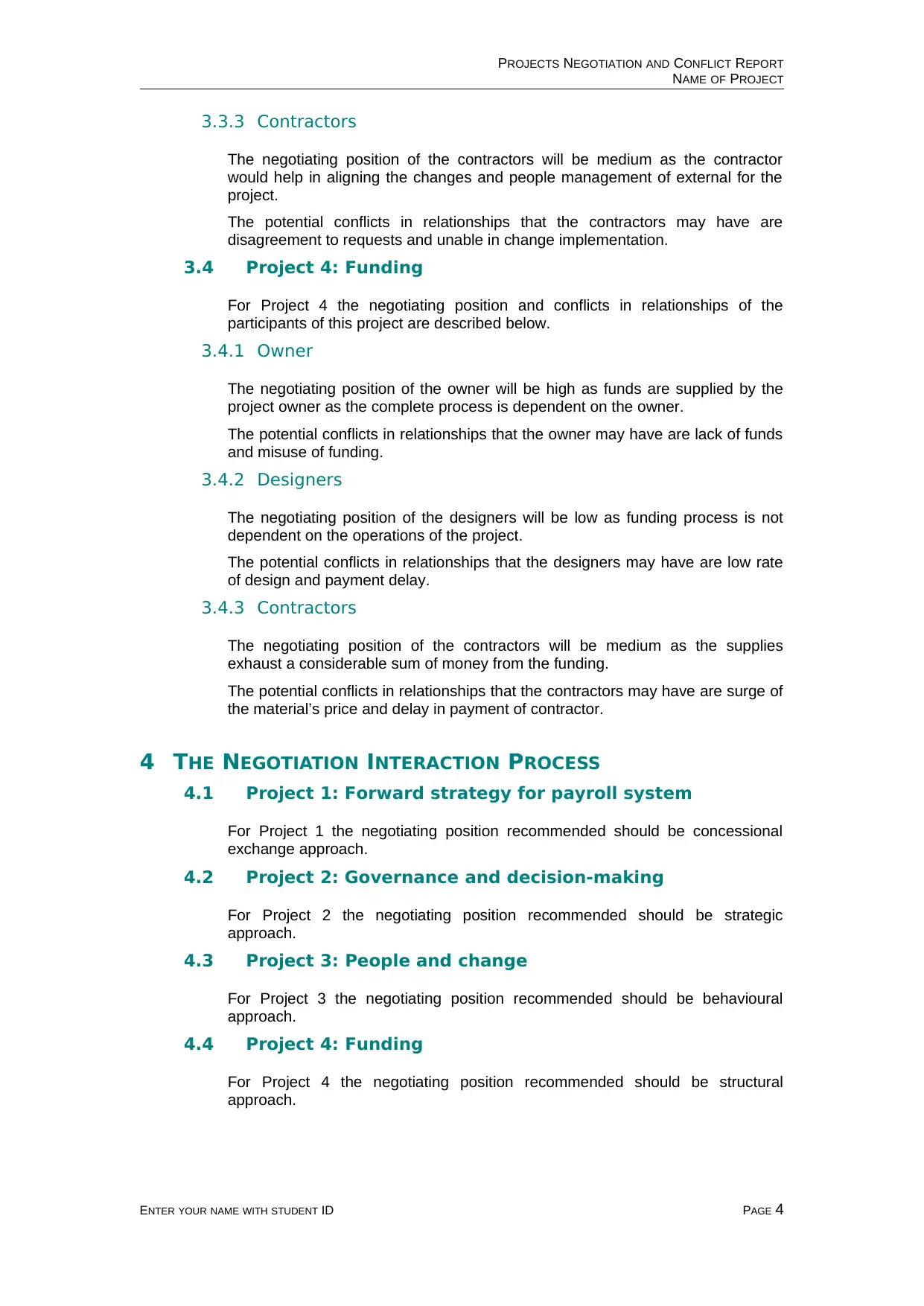
PROJECTS NEGOTIATION AND CONFLICT REPORT
NAME OF PROJECT
3.3.3 Contractors
The negotiating position of the contractors will be medium as the contractor
would help in aligning the changes and people management of external for the
project.
The potential conflicts in relationships that the contractors may have are
disagreement to requests and unable in change implementation.
3.4 Project 4: Funding
For Project 4 the negotiating position and conflicts in relationships of the
participants of this project are described below.
3.4.1 Owner
The negotiating position of the owner will be high as funds are supplied by the
project owner as the complete process is dependent on the owner.
The potential conflicts in relationships that the owner may have are lack of funds
and misuse of funding.
3.4.2 Designers
The negotiating position of the designers will be low as funding process is not
dependent on the operations of the project.
The potential conflicts in relationships that the designers may have are low rate
of design and payment delay.
3.4.3 Contractors
The negotiating position of the contractors will be medium as the supplies
exhaust a considerable sum of money from the funding.
The potential conflicts in relationships that the contractors may have are surge of
the material’s price and delay in payment of contractor.
4 THE NEGOTIATION INTERACTION PROCESS
4.1 Project 1: Forward strategy for payroll system
For Project 1 the negotiating position recommended should be concessional
exchange approach.
4.2 Project 2: Governance and decision-making
For Project 2 the negotiating position recommended should be strategic
approach.
4.3 Project 3: People and change
For Project 3 the negotiating position recommended should be behavioural
approach.
4.4 Project 4: Funding
For Project 4 the negotiating position recommended should be structural
approach.
ENTER YOUR NAME WITH STUDENT ID PAGE 4
NAME OF PROJECT
3.3.3 Contractors
The negotiating position of the contractors will be medium as the contractor
would help in aligning the changes and people management of external for the
project.
The potential conflicts in relationships that the contractors may have are
disagreement to requests and unable in change implementation.
3.4 Project 4: Funding
For Project 4 the negotiating position and conflicts in relationships of the
participants of this project are described below.
3.4.1 Owner
The negotiating position of the owner will be high as funds are supplied by the
project owner as the complete process is dependent on the owner.
The potential conflicts in relationships that the owner may have are lack of funds
and misuse of funding.
3.4.2 Designers
The negotiating position of the designers will be low as funding process is not
dependent on the operations of the project.
The potential conflicts in relationships that the designers may have are low rate
of design and payment delay.
3.4.3 Contractors
The negotiating position of the contractors will be medium as the supplies
exhaust a considerable sum of money from the funding.
The potential conflicts in relationships that the contractors may have are surge of
the material’s price and delay in payment of contractor.
4 THE NEGOTIATION INTERACTION PROCESS
4.1 Project 1: Forward strategy for payroll system
For Project 1 the negotiating position recommended should be concessional
exchange approach.
4.2 Project 2: Governance and decision-making
For Project 2 the negotiating position recommended should be strategic
approach.
4.3 Project 3: People and change
For Project 3 the negotiating position recommended should be behavioural
approach.
4.4 Project 4: Funding
For Project 4 the negotiating position recommended should be structural
approach.
ENTER YOUR NAME WITH STUDENT ID PAGE 4
Secure Best Marks with AI Grader
Need help grading? Try our AI Grader for instant feedback on your assignments.
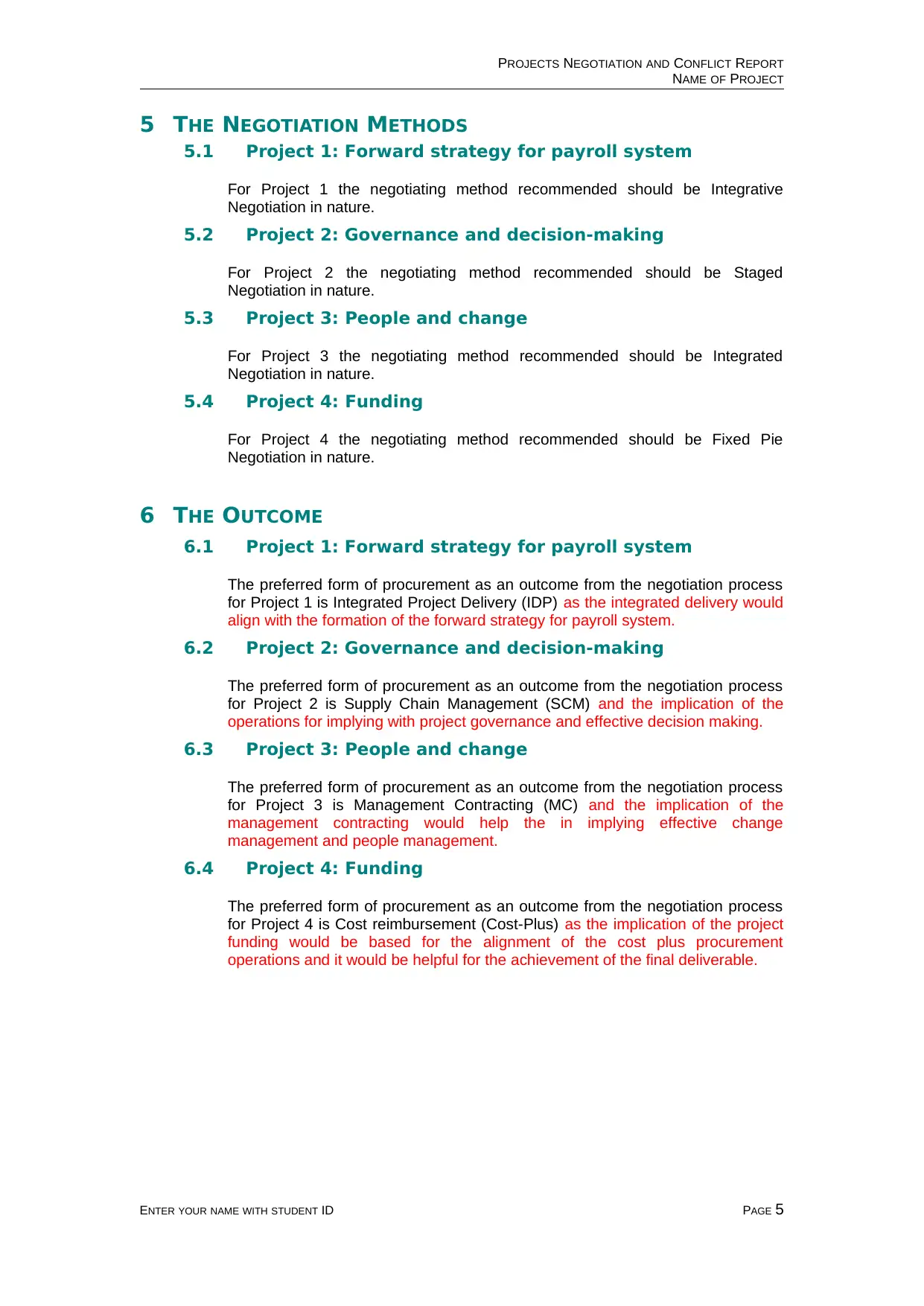
PROJECTS NEGOTIATION AND CONFLICT REPORT
NAME OF PROJECT
5 THE NEGOTIATION METHODS
5.1 Project 1: Forward strategy for payroll system
For Project 1 the negotiating method recommended should be Integrative
Negotiation in nature.
5.2 Project 2: Governance and decision-making
For Project 2 the negotiating method recommended should be Staged
Negotiation in nature.
5.3 Project 3: People and change
For Project 3 the negotiating method recommended should be Integrated
Negotiation in nature.
5.4 Project 4: Funding
For Project 4 the negotiating method recommended should be Fixed Pie
Negotiation in nature.
6 THE OUTCOME
6.1 Project 1: Forward strategy for payroll system
The preferred form of procurement as an outcome from the negotiation process
for Project 1 is Integrated Project Delivery (IDP) as the integrated delivery would
align with the formation of the forward strategy for payroll system.
6.2 Project 2: Governance and decision-making
The preferred form of procurement as an outcome from the negotiation process
for Project 2 is Supply Chain Management (SCM) and the implication of the
operations for implying with project governance and effective decision making.
6.3 Project 3: People and change
The preferred form of procurement as an outcome from the negotiation process
for Project 3 is Management Contracting (MC) and the implication of the
management contracting would help the in implying effective change
management and people management.
6.4 Project 4: Funding
The preferred form of procurement as an outcome from the negotiation process
for Project 4 is Cost reimbursement (Cost-Plus) as the implication of the project
funding would be based for the alignment of the cost plus procurement
operations and it would be helpful for the achievement of the final deliverable.
ENTER YOUR NAME WITH STUDENT ID PAGE 5
NAME OF PROJECT
5 THE NEGOTIATION METHODS
5.1 Project 1: Forward strategy for payroll system
For Project 1 the negotiating method recommended should be Integrative
Negotiation in nature.
5.2 Project 2: Governance and decision-making
For Project 2 the negotiating method recommended should be Staged
Negotiation in nature.
5.3 Project 3: People and change
For Project 3 the negotiating method recommended should be Integrated
Negotiation in nature.
5.4 Project 4: Funding
For Project 4 the negotiating method recommended should be Fixed Pie
Negotiation in nature.
6 THE OUTCOME
6.1 Project 1: Forward strategy for payroll system
The preferred form of procurement as an outcome from the negotiation process
for Project 1 is Integrated Project Delivery (IDP) as the integrated delivery would
align with the formation of the forward strategy for payroll system.
6.2 Project 2: Governance and decision-making
The preferred form of procurement as an outcome from the negotiation process
for Project 2 is Supply Chain Management (SCM) and the implication of the
operations for implying with project governance and effective decision making.
6.3 Project 3: People and change
The preferred form of procurement as an outcome from the negotiation process
for Project 3 is Management Contracting (MC) and the implication of the
management contracting would help the in implying effective change
management and people management.
6.4 Project 4: Funding
The preferred form of procurement as an outcome from the negotiation process
for Project 4 is Cost reimbursement (Cost-Plus) as the implication of the project
funding would be based for the alignment of the cost plus procurement
operations and it would be helpful for the achievement of the final deliverable.
ENTER YOUR NAME WITH STUDENT ID PAGE 5
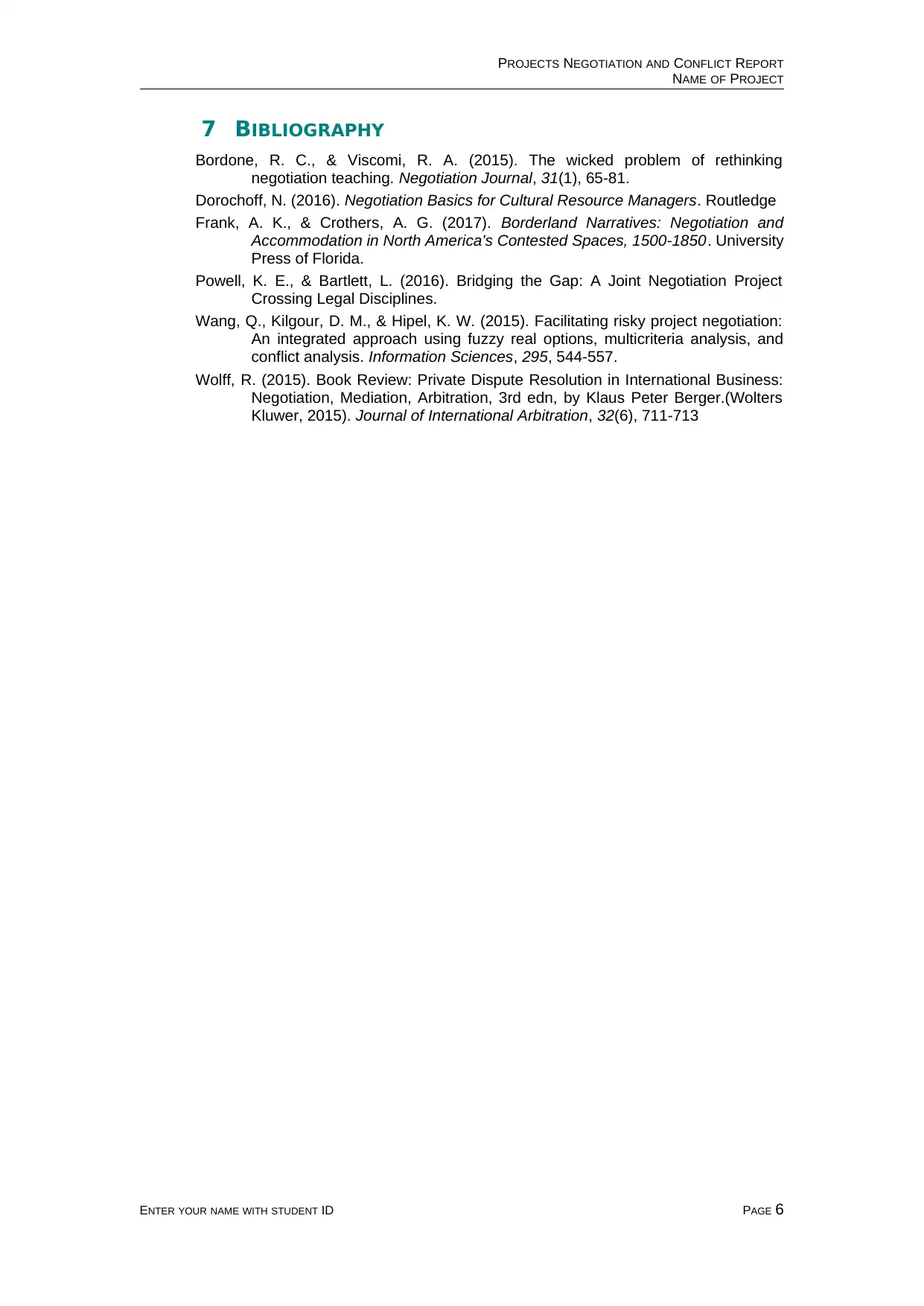
PROJECTS NEGOTIATION AND CONFLICT REPORT
NAME OF PROJECT
7 BIBLIOGRAPHY
Bordone, R. C., & Viscomi, R. A. (2015). The wicked problem of rethinking
negotiation teaching. Negotiation Journal, 31(1), 65-81.
Dorochoff, N. (2016). Negotiation Basics for Cultural Resource Managers. Routledge
Frank, A. K., & Crothers, A. G. (2017). Borderland Narratives: Negotiation and
Accommodation in North America's Contested Spaces, 1500-1850. University
Press of Florida.
Powell, K. E., & Bartlett, L. (2016). Bridging the Gap: A Joint Negotiation Project
Crossing Legal Disciplines.
Wang, Q., Kilgour, D. M., & Hipel, K. W. (2015). Facilitating risky project negotiation:
An integrated approach using fuzzy real options, multicriteria analysis, and
conflict analysis. Information Sciences, 295, 544-557.
Wolff, R. (2015). Book Review: Private Dispute Resolution in International Business:
Negotiation, Mediation, Arbitration, 3rd edn, by Klaus Peter Berger.(Wolters
Kluwer, 2015). Journal of International Arbitration, 32(6), 711-713
ENTER YOUR NAME WITH STUDENT ID PAGE 6
NAME OF PROJECT
7 BIBLIOGRAPHY
Bordone, R. C., & Viscomi, R. A. (2015). The wicked problem of rethinking
negotiation teaching. Negotiation Journal, 31(1), 65-81.
Dorochoff, N. (2016). Negotiation Basics for Cultural Resource Managers. Routledge
Frank, A. K., & Crothers, A. G. (2017). Borderland Narratives: Negotiation and
Accommodation in North America's Contested Spaces, 1500-1850. University
Press of Florida.
Powell, K. E., & Bartlett, L. (2016). Bridging the Gap: A Joint Negotiation Project
Crossing Legal Disciplines.
Wang, Q., Kilgour, D. M., & Hipel, K. W. (2015). Facilitating risky project negotiation:
An integrated approach using fuzzy real options, multicriteria analysis, and
conflict analysis. Information Sciences, 295, 544-557.
Wolff, R. (2015). Book Review: Private Dispute Resolution in International Business:
Negotiation, Mediation, Arbitration, 3rd edn, by Klaus Peter Berger.(Wolters
Kluwer, 2015). Journal of International Arbitration, 32(6), 711-713
ENTER YOUR NAME WITH STUDENT ID PAGE 6
1 out of 6
Related Documents
Your All-in-One AI-Powered Toolkit for Academic Success.
+13062052269
info@desklib.com
Available 24*7 on WhatsApp / Email
![[object Object]](/_next/static/media/star-bottom.7253800d.svg)
Unlock your academic potential
© 2024 | Zucol Services PVT LTD | All rights reserved.
